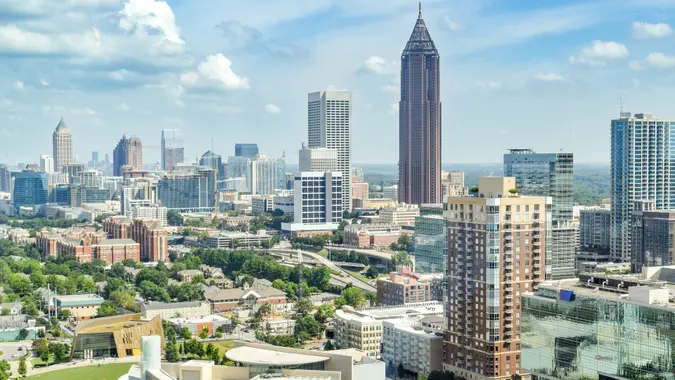Will Your Job Be Affected by the Heat? How the US Economy Is Losing Billions

Commitment to Our Readers
GOBankingRates' editorial team is committed to bringing you unbiased reviews and information. We use data-driven methodologies to evaluate financial products and services - our reviews and ratings are not influenced by advertisers. You can read more about our editorial guidelines and our products and services review methodology.

20 Years
Helping You Live Richer

Reviewed
by Experts

Trusted by
Millions of Readers
Working while it’s hot outside is not only uncomfortable but also a financial drain. High temperatures cause workers to lose both hours and productivity, and the effect on the economy at large is huge. According to a report from the Adrienne Arsht-Rockefeller Foundation Resilience Center, the loss of labor as a result of heat exposure cost the economy about $100 billion in 2020 alone, and that number is expected to hit $500 billion annually by 2050.
Another report by the Lancet, found more than 2.5 billion hours of labor in the U.S. agriculture, manufacturing, service and construction sectors were lost due to the heat in 2021 alone. But how does heat tie into economic loss in the U.S., and what does it mean for your job?
Why Do High Temperatures Cost the U.S. Economy?
High temperatures take a toll on the U.S. economy in a number of ways, but the effect on human productivity and safety is often overlooked. It’s clear that climate change has had devastating physical effects on goods produced in the United States, with higher-than-normal temperatures drying out crops and stronger-than-normal storms creating flood damage.
Insurance rates have also risen in response to the increasing frequency of these natural calamities, according to the New York Times. But the loss of worker productivity and jobs has also resulted in significant losses to the American economy.
Research from the International Journal of Biometeorology has found that once temperatures break 90 degrees Fahrenheit, productivity drops by 25%. As the mercury crosses 100 degrees, productivity falls off a cliff, dropping by a whopping 70%.
Data from IOPscience finds that workers end up losing money the higher the temperature rises, with losses being disproportionately allocated to poorer counties over wealthier ones. Specifically, workers in poorer counties lose up to 5% of their pay per hot day, versus just 1% per day in wealthier counties. This could be due to a combination of factors, from the fact that workers in poorer counties tend to do more labor-intensive jobs to the ability of wealthier counties to provide more adequate protections for workers.
Is Your Job Safe From Heat-Related Job Losses?
Based on the data from these researchers, you’re more likely to lose your job due to climate change and rising temperatures if you work in a poor county versus a wealthy one. IOPscience predicts job losses in poorer counties due to climate change will run at 4.8% annually from 2040 to 2050, compared to virtually no change in wealthier counties.
This is due in large part to the fact that workers in poorer counties are simply subjected to more heat. The IOPscience data projects that in the United States, the rich will be exposed to 50 fewer days of temperatures greater than 90 degrees Fahrenheit than the poor.
Some industries affected by higher heat are more obvious than others. Construction workers and field laborers, for example, are clearly exposed to more days of direct sun than those in many other occupations. However, some indoor workers are also subjected to excess heat. Meatpackers and food processing workers, for example, routinely face high-heat environments. Their work environment may be more dangerous that the conditions of those who work outdoors, as they may not get adequate ventilation and fresh air.
Even fast-food workers can be overwhelmed if they hover over hot ovens and deep fryers for long stretches without adequate air conditioning systems. On July 21, for example, some McDonald’s workers in Los Angeles walked off the job because their in-store cooling was no match for the city’s heat wave.
The Bottom Line
Using this data as a baseline, it suggests the best way to protect yourself from heat-related job loss is to reduce your exposure on days when the temperature exceeds 90 degrees Fahrenheit. This could be achieved by working in a wealthier county or in a job that doesn’t require exposure to intense heat.
In addition to the fact that many Americans don’t want to move to a new county or work at a different job, this type of transition is not always financially feasible. The fact remains that increases in heat exposure, particularly above 90 or 100 degrees Fahrenheit, results in loss of productivity, reduced wages and the higher potential for job loss.
More From GOBankingRates
- Nearly 1 in 3 Americans Hit by a Costly Holiday Scam, Norton Survey Shows -- How To Avoid This
- Here's What Retirees Wasted the Most Money On in 2025 -- and How To Avoid It in 2026
- How Middle-Class Earners Are Quietly Becoming Millionaires -- and How You Can, Too
- 6 Safe Accounts Proven to Grow Your Money Up to 13x Faster
 Written by
Written by  Edited by
Edited by 

























